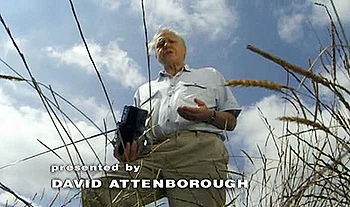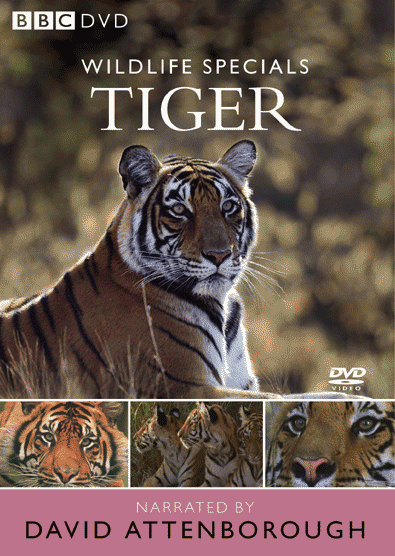
BBC Wildlife Specials
Encyclopedia
The BBC Wildlife Specials are a series of nature documentary programmes commissioned by BBC Television
. The Wildlife Specials began with a pilot episode in 1995. A further 15 programmes were made over the next decade, and more recently the format has been expanded into two short series. The earlier programmes were produced in-house by the BBC's specialist Natural History Unit
, but the more recent Spy in the... titles are made by the independent producer John Downer Productions. Each Wildlife Special is narrated by David Attenborough
(except for the 2010 Polar Bear: Spy on the Ice which was narrated by David Tennant
) and features one of the most high-profile animals of the natural world.
. Following a pilot episode on the great white shark
in 1995, a sequence of six further programmes were transmitted in 1997, screened as part of the Natural History Unit's 40th anniversary celebrations. Later programmes were screened on an intermittent basis, typically at holiday times to attract a family audience. Viewing figures for the 1997 series peaked at 9.5 million viewers for the polar bear
special.
Although they are frequently filmed subjects, the Wildlife Specials incorporate the latest filming techniques and scientific research to present the creatures in a new light, as described in the examples below:
 A list of programme titles with original broadcast date:
A list of programme titles with original broadcast date:

Many of the later Specials have also been given DVD releases. Lions: Spy in the Den, Elephants: Spy in the Herd and Bears: Spy in the Woods were collectively released as The Spy in the... Collection (BBCDVD1996) on 2 October 2006. Trek: Spy on the Wildebeest (BBCDVD2760) and Tiger: Spy in the Jungle (BBCDVD2759) were released on individual DVDs on 9 June 2008.
To accompany the 1997 Specials, a hardcover book The BBC Natural History Unit's Wildlife Specials (ISBN 1-900-72416-2) was published by Trident Press on 10 November 1997 with a foreword by David Attenborough, an introduction by series producer Keith Scholey, and a chapter on each of the six animals by the individual programme producers.
BBC Television
BBC Television is a service of the British Broadcasting Corporation. The corporation, which has operated in the United Kingdom under the terms of a Royal Charter since 1927, has produced television programmes from its own studios since 1932, although the start of its regular service of television...
. The Wildlife Specials began with a pilot episode in 1995. A further 15 programmes were made over the next decade, and more recently the format has been expanded into two short series. The earlier programmes were produced in-house by the BBC's specialist Natural History Unit
BBC Natural History Unit
The BBC Natural History Unit is a department of the BBC dedicated to making television and radio programmes with a natural history or wildlife theme, especially nature documentaries...
, but the more recent Spy in the... titles are made by the independent producer John Downer Productions. Each Wildlife Special is narrated by David Attenborough
David Attenborough
Sir David Frederick Attenborough OM, CH, CVO, CBE, FRS, FZS, FSA is a British broadcaster and naturalist. His career as the face and voice of natural history programmes has endured for more than 50 years...
(except for the 2010 Polar Bear: Spy on the Ice which was narrated by David Tennant
David Tennant
David Tennant is a Scottish actor. In addition to his work in theatre, including a widely praised Hamlet, Tennant is best known for his role as the tenth incarnation of the Doctor in Doctor Who, along with the title role in the 2005 TV serial Casanova and as Barty Crouch, Jr...
) and features one of the most high-profile animals of the natural world.
Broadcast and production history
The Wildlife Specials have always been broadcast on BBC OneBBC One
BBC One is the flagship television channel of the British Broadcasting Corporation in the United Kingdom. It was launched on 2 November 1936 as the BBC Television Service, and was the world's first regular television service with a high level of image resolution...
. Following a pilot episode on the great white shark
Great white shark
The great white shark, scientific name Carcharodon carcharias, also known as the great white, white pointer, white shark, or white death, is a large lamniform shark found in coastal surface waters in all major oceans. It is known for its size, with the largest individuals known to have approached...
in 1995, a sequence of six further programmes were transmitted in 1997, screened as part of the Natural History Unit's 40th anniversary celebrations. Later programmes were screened on an intermittent basis, typically at holiday times to attract a family audience. Viewing figures for the 1997 series peaked at 9.5 million viewers for the polar bear
Polar Bear
The polar bear is a bear native largely within the Arctic Circle encompassing the Arctic Ocean, its surrounding seas and surrounding land masses. It is the world's largest land carnivore and also the largest bear, together with the omnivorous Kodiak Bear, which is approximately the same size...
special.
Although they are frequently filmed subjects, the Wildlife Specials incorporate the latest filming techniques and scientific research to present the creatures in a new light, as described in the examples below:
- The eagleEagleEagles are members of the bird family Accipitridae, and belong to several genera which are not necessarily closely related to each other. Most of the more than 60 species occur in Eurasia and Africa. Outside this area, just two species can be found in the United States and Canada, nine more in...
film uses aerial photography to capture dramatic scenes of the birds, including dropping tortoises from a great height to smash their shells open. 15 of the world's 60 species of eagle were filmed for this programme. - The leopardLeopardThe leopard , Panthera pardus, is a member of the Felidae family and the smallest of the four "big cats" in the genus Panthera, the other three being the tiger, lion, and jaguar. The leopard was once distributed across eastern and southern Asia and Africa, from Siberia to South Africa, but its...
film uses infra-red cameras to reveal previously unseen nocturnal activity of the cats hunting baboons. - In the polar bearPolar BearThe polar bear is a bear native largely within the Arctic Circle encompassing the Arctic Ocean, its surrounding seas and surrounding land masses. It is the world's largest land carnivore and also the largest bear, together with the omnivorous Kodiak Bear, which is approximately the same size...
film, the producer and cameraman were trapped on an ice floe for 20 hours, but managed to capture the first scenes of new-born cubs in the den. - Groundbreaking high-speed photography, x-ray imaging and miniature cameras attached to the heads of snakeSnakeSnakes are elongate, legless, carnivorous reptiles of the suborder Serpentes that can be distinguished from legless lizards by their lack of eyelids and external ears. Like all squamates, snakes are ectothermic, amniote vertebrates covered in overlapping scales...
s brought new and revealing behaviour. - A specially constructed, remote-controlled airship was used to capture aerial footage of humpback whaleHumpback WhaleThe humpback whale is a species of baleen whale. One of the larger rorqual species, adults range in length from and weigh approximately . The humpback has a distinctive body shape, with unusually long pectoral fins and a knobbly head. It is an acrobatic animal, often breaching and slapping the...
s as they breached, scooping thousands of fish into their mouths - The programme on lions was the first to be commissioned from an independent production company. The filmmakers at John Downer Productions used their previous experience from ground-breaking films such as In-Flight Movie to develop a range of mobile, remote-controlled cameras. "Boulder cam" was disguised as a rock and enabled the first footage from inside a pride's den to be captured. This technique was developed further for the later Spy in the... programmes on elephants and bearBearBears are mammals of the family Ursidae. Bears are classified as caniforms, or doglike carnivorans, with the pinnipeds being their closest living relatives. Although there are only eight living species of bear, they are widespread, appearing in a wide variety of habitats throughout the Northern...
s. - For the 2-part special Trek – Spy on the Wildebeest, cameras disguised as tortoises and crocodiles and an aerial camera christened "Dragonfly Cam" were developed.
- In Tiger – Spy in the Jungle, trained elephants carried and deployed "Trunk Cam" and "Tusk Cam", whilst "Log Cam" gathered unique footage of India's jungle wildlife.
Programmes

- Great White Shark: The True Story of Jaws (1995-04-14)
- Polar Bear: The Arctic Warrior (1997-11-26)
- Crocodile: The Smiling Predator (1997-12-03)
- Leopard: The Agent of Darkness (1997-12-10)
- Eagle: The Master of the Skies (1997-12-17)
- Humpback Whale: The Giant of the Oceans (1997-12-24)
- Wolf: The Legendary Outlaw (1997-12-31)
- Tiger: The Elusive Princess (1999-04-04)
- Lions: Spy in the Den (2000-12-03)
- Grizzly: Face to Face (2001-04-08)
- Gorillas: On the Trail of King Kong (2002-02-03)
- Serpent: Through the Eyes of the Snake (2002-04-10)
- Killer Whale (2003-04-09)
- Elephants: Spy in the Herd (2003-07-20)
- Smart Sharks: Swimming With Roboshark (2003-08-03)
- Bears: Spy in the Woods (2004-11-30)
- Trek: Spy on the Wildebeest two-part series
- Episode 1: "The Journey" (2007-01-14)
- Episode 2: "The Crossing" (2007-01-21)
- Tiger: Spy in the Jungle three-part series
- Episode 1 (2008-03-30)
- Episode 2 (2008-04-06)
- Episode 3 (2008-04-13)
- Polar Bear: Spy on the Ice (2010-12-29)
Awards

- Leopard won the Award for Innovation at the 1998 Jackson Hole Wildlife Film Festival
- Polar Bear won the Best Factual Photography award at the 1998 BAFTAs
- Tiger won the Best Factual Photography award at the 2000 BAFTAs
- A scene of a python swallowing an antelope whole, from Serpent, won Best Factual Moment at the BBC's 2002 TV Moments awards show
Merchandise
To date, four of the early Specials have been released on DVD on 23 May 2004 both individually and as a box set (BBCDVD1580); they are Eagle (BBCVD1481), Serpent (BBCDVD1482), Leopard (BBCDVD1483) and Tiger (BBCDVD1485). The first eight Specials were also previously released on VHS.Many of the later Specials have also been given DVD releases. Lions: Spy in the Den, Elephants: Spy in the Herd and Bears: Spy in the Woods were collectively released as The Spy in the... Collection (BBCDVD1996) on 2 October 2006. Trek: Spy on the Wildebeest (BBCDVD2760) and Tiger: Spy in the Jungle (BBCDVD2759) were released on individual DVDs on 9 June 2008.
To accompany the 1997 Specials, a hardcover book The BBC Natural History Unit's Wildlife Specials (ISBN 1-900-72416-2) was published by Trident Press on 10 November 1997 with a foreword by David Attenborough, an introduction by series producer Keith Scholey, and a chapter on each of the six animals by the individual programme producers.

